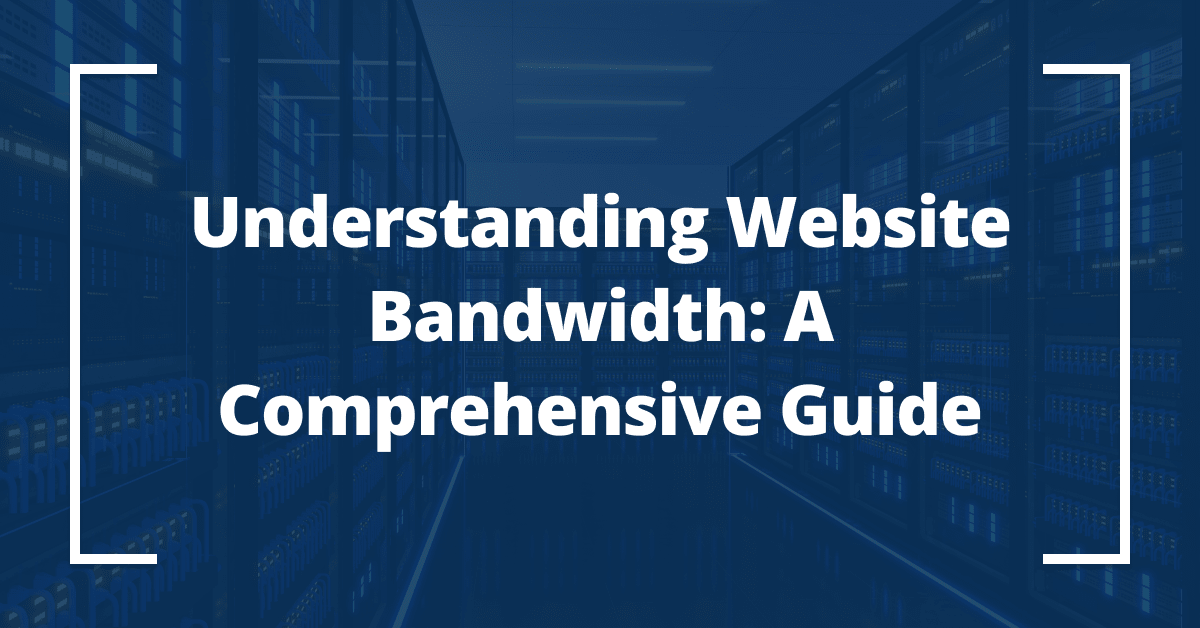
[ad_1]
In this digital era, a website’s performance can make or break its success. Users expect instant access to information, swift loading times, and seamless browsing experiences. Behind the scenes, one crucial factor that contributes to the speed and determines the efficiency and accessibility of a website is bandwidth.
Picture bandwidth as a digital highway that connects your website’s server to your visitors’ devices. It determines the volume of data that can flow through this virtual conduit at any given moment, affecting how swiftly your web pages load and how smoothly your content is delivered.
Understanding and effectively managing bandwidth is the key to ensuring that your website or eCommerce store operates like a well-oiled machine, providing a seamless and enjoyable user experience.
Choosing a web hosting plan that offers adequate bandwidth is, therefore, paramount. It ensures your website can accommodate its current needs and future growth. This comprehensive guide will help you navigate the intricacies of website bandwidth. You’ll learn about the factors that influence bandwidth usage and how to calculate your website’s bandwidth requirements, optimize bandwidth usage, and choose a web hosting plan that best suits your bandwidth needs.
Whether you’re a seasoned web professional or a curious beginner, the information in this post will equip you with the knowledge and insights you need to have complete control over your bandwidth to create a lightning-fast, user-centric website.
What is bandwidth?
Bandwidth refers to the capacity or speed at which data can travel over a network connection. It is an essential factor in our daily digital interactions, whether surfing the web, streaming videos, or transferring files.
Simply put, imagine you have a pipe supplying water to your home – the size of the pipe represents the bandwidth, and the water flowing through it symbolizes the data being transmitted. Just as a wider pipe allows more water to flow at any given time, a higher bandwidth enables a greater volume of data to be transferred across a network connection in a time-efficient manner.

The amount of bandwidth is typically measured in bits per second (bps) and is commonly expressed as megabits per second (Mbps) or gigabits per second (Gbps).
Having higher bandwidth results in the following:
- Faster and more efficient web page load times — This ensures a seamless browsing experience. In contrast, a low-bandwidth connection can result in frustratingly slow page loading times and delays.
- Speedier media streaming — If you have limited bandwidth, an online video may buffer frequently, causing interruptions and disrupting the viewing experience. With a higher bandwidth connection, video streaming will be faster.
- Enhanced online gaming experiences — A high-bandwidth connection minimizes latency, allowing gamers to react swiftly and savor a lag-free gaming session.
It’s worth noting that the available bandwidth can vary depending on the type of Internet connection being used. Broadband connections, such as cable or fiber optic, typically offer higher bandwidth than dial-up or satellite connections.
Nevertheless, different web hosting plans may provide varying bandwidth capacities even within broadband options. That’s why it’s vital to consider your bandwidth requirements when choosing a hosting provider.
Factors affecting bandwidth usage
Website bandwidth usage is influenced by a multitude of factors, each playing a significant role in how much data is transferred between your site and its visitors. Understanding these factors can help you better pinpoint and manage your bandwidth requirements and make an informed decision on the hosting plan most suitable for your online project.
- Site traffic — The number of visitors and page views your website receives directly affects your bandwidth usage. For instance, if your site has a high volume of traffic, it will consume more bandwidth than a site with fewer visitors.
- Page size —The size of your web pages, particularly the media files (such as images and videos), also impacts bandwidth usage. Larger files require more data to be transferred, thereby consuming more bandwidth.
- Website design and layout —The complexity of your website’s design and layout can influence bandwidth usage. Websites with intricate designs, heavy use of plugins, and dynamic content often require more bandwidth.
- Content management system (CMS) and server-side technologies —The CMS and server-side technologies you use can also affect bandwidth. Some CMS platforms and technologies are more resource-intensive than others, leading to higher bandwidth usage.
- Use of content delivery network (CDN) or caching techniques —Implementing a CDN or caching technique can help reduce bandwidth usage by storing and delivering content closer to your site’s visitors.
These factors are interrelated and can all contribute to the overall bandwidth usage of your website. The good news is that there are ways to optimize these factors to reduce bandwidth usage and improve website performance.
Calculating your website’s bandwidth requirements
Underestimating bandwidth can lead to slow page load times, website crashes, and a poor user experience, while overestimating can result in unnecessary costs. Exceeding your hosting plan’s bandwidth limits can also lead to additional fees or even suspension of services.
To avoid these pitfalls, follow these steps to calculate how much bandwidth your website requires:
1. Estimate average page size
Start by determining the average size of your web pages. This includes all the elements on the page, like images, videos, text, and other components.
You can measure this in kilobytes (KB) or megabytes (MB), but be consistent in your measurement unit.
2. Determine average page views per month
Calculate the average number of page views your website receives each month. Consider factors such as website traffic, seasonality, and growth projections.
You can obtain these metrics from website analytics tools like Google Analytics.
3. Calculate the total monthly bandwidth usage
Multiply the average page size by the average number of page views per month. This will give you your total monthly bandwidth usage.
4. Add a buffer
Finally, add a buffer of around 20-50% to your calculated bandwidth to account for unexpected traffic spikes, growth, and other variables.
While these steps provide a basic calculation, it’s important to factor in other variables that can affect bandwidth usage. Techniques like file compression, caching, and using a CDN can significantly reduce your bandwidth usage.
Optimizing your website’s bandwidth usage
Optimizing your website’s bandwidth usage can significantly improve website performance, reduce hosting costs, and enhance user experience. Here are some approaches to consider:
- Compress files —Compress images and other media files to reduce their size without significantly compromising quality. This reduces the amount of data that needs to be transferred, thereby saving bandwidth.
- Minimize large files — Limit the use of large files, such as high-resolution images and videos, which can consume significant bandwidth. Go for optimized, web-friendly formats wherever possible.
- Implement caching techniques — Use browser and server-side caching to store and serve static content more efficiently. This reduces the need for repeated data transfers, thereby conserving bandwidth.
- Use a content delivery network —A CDN distributes your content across multiple servers, reducing the load on your main server and decreasing data transfer times.
- Optimize website design — Streamline your website design and layout to minimize the number of HTTP requests, which can reduce server load and save bandwidth.
- Update regularly — Keep your CMS, plugins, and other server-side technologies up to date to ensure optimal performance and efficient bandwidth usage.
By implementing these strategies, you can make the most of your bandwidth and provide a seamless browsing experience for your visitors.
Monitoring and adjusting bandwidth
Regular monitoring of your website helps identify potential issues, optimize performance, and prevent exceeding your hosting plan’s limits.
You can monitor bandwidth usage through website analytics tools, server logs, and hosting control panels. These tools provide valuable insights into your site’s data consumption, allowing you to identify patterns and trends in bandwidth usage.
For example, while monitoring your bandwidth usage, you might notice that certain pages with large images are consuming more bandwidth, indicating a need for image compression.
As your website grows and evolves, your bandwidth requirements will likely change, putting you at risk of outgrowing your IT infrastructure. Changes in traffic patterns, the addition of new features, or an increase in page views can all impact your bandwidth usage. Therefore, it’s important to regularly adjust your bandwidth requirements and hosting plan to accommodate these changes.
Liquid Web’s hosting plans offer the flexibility and scalability needed to adjust to changing bandwidth needs. Whether you’re a small business looking for tailored solutions, a high-traffic website requiring high availability hosting, or a business with multiple virtual machines needing VMware private cloud hosting, Liquid Web has a solution to meet your needs.
Choosing the right web hosting bandwidth plan
Choosing an appropriate web hosting plan that meets your website’s bandwidth requirements is essential for supporting its growth and ensuring optimal performance. Consider the following features when selecting a hosting plan:
- Estimated bandwidth requirements —Based on the calculations and projections we discussed earlier, choose a plan that accommodates your estimated bandwidth needs.
- Scalability and flexibility — Look for hosting plans that offer the flexibility to upgrade your server and scale up as your bandwidth needs change and grow.
- Reliability and performance —Consider factors like uptime guarantees and server response times. A reliable hosting plan contributes to a seamless user experience.
- Security and compliance — Choose a hosting plan that offers robust security features to protect sensitive data and meet industry regulations.
- Customer support —Opt for a hosting service provider that offers excellent customer support and can assist you with any issues related to bandwidth management.
Liquid Web offers a wide range of hosting plans that cater to various bandwidth requirements and customer needs. With fast and reliable performance, secure and compliant plans, and high availability, hassle-free managed hosting (including WordPress), Liquid Web ensures your website’s bandwidth needs are met, supporting your growth and success.
Limitations of unlimited bandwidth plans
Unlimited bandwidth plans can seem attractive, but it’s important to understand they often come with restrictions or hidden constraints. These plans may offer unlimited bandwidth on the surface, but in reality, they might result in slower performance due to shared server resources.
In some cases, providers may throttle or even suspend services if they deem your usage to be excessive, despite the unlimited label. This can lead to unexpected disruptions in your website’s performance, negatively impacting your user experience and, potentially, your business.
Ultimately, it’s necessary to carefully review the terms and conditions of any hosting plan and understand any impediments to bandwidth usage before making a decision. Prioritize transparency and reliability in product offerings. Choose a provider that offers clear pricing and specifications, catering to various bandwidth needs without hidden limitations. This ensures you have a hosting plan that genuinely supports your website’s growth and performance.
Boost your site’s performance with Liquid Web’s fast and reliable hosting solutions
Understanding your website’s bandwidth usage, calculating requirements, optimizing usage, and choosing the right hosting plan are all critical steps in boosting your site’s performance. By optimizing your bandwidth, you can improve your website’s performance, enhance user experience, and reduce hosting costs.
Take the time to review your current bandwidth usage, implement the optimization strategies discussed in this post, and consider a hosting plan that meets your website’s unique requirements.
Speaking of which, Liquid Web offers fast and reliable hosting solutions that cater to a wide range of bandwidth needs. With secure and compliant hosting, hassle-free managed server plans, tailored solutions for SMBs, and high availability hosting, Liquid Web ensures your website runs smoothly and efficiently.
Moreover, Liquid Web’s customer support is always ready to offer personalized advice and assistance. They can help you understand your website’s bandwidth needs and choose the best hosting plan to support your growth and success.
What are you waiting for? Take the first step towards optimizing your website’s bandwidth today, and sign up for Liquid Web’s hosting!
[ad_2]
Source link






